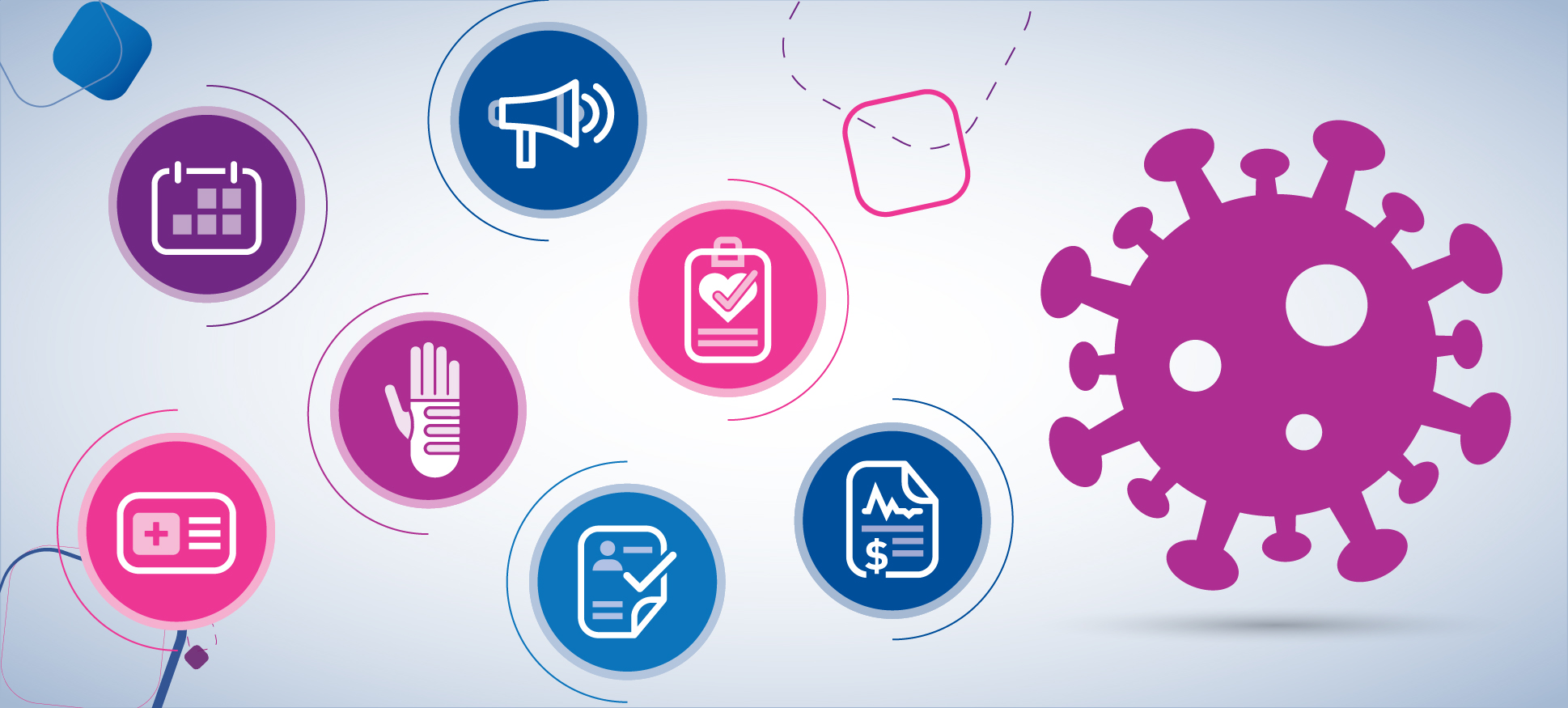Patient Experience
Learn how your organization can drive patient loyalty and create excellent patient experiences, every time.

Patient experience may not be the first consideration that comes to mind when you're looking to improve revenue cycle management (RCM). However, a positive patient experience can benefit RCM. It can make the complicated process of understanding and managing healthcare finances simpler and more seamless for patients—and facilitate an easy-to-navigate continuum of care that includes RCM. Financial transparency plays a significant role in building trust and confidence between patient and provider. Patients who may find it difficult to understand medical billing and health insurance coverage—and who are paying more out-of-pocket costs thanks to high-deductible health plans—appreciate accurate estimates and a range of convenient payment options. By optimizing back-end claims, billing, payment and collections processes, providers free up staff to provide individualized help to patients who need it. Strategies to bolster patient experience and RCM Patients who have grown accustomed to using digital platforms for everything from online shopping to food delivery, travel, managing finances and entertainment gravitate toward digital tools and expect a high level of functionality. In a Salesforce survey of 15,000 consumers, 68% of respondents said their expectations of companies' digital capabilities increased after COVID-19 drove more of their activity online. Providing a superior digital experience is now synonymous with good service, but healthcare is lagging behind other service sectors. For providers, automation and data analytics can streamline workflows and improve efficiencies. These factors are critical as staff find themselves under increasing pressure to provide accurate patient estimates upfront and to submit claims accurately to reduce denials. How can providers use the patient experience to improve RCM? Here are a few areas of focus to consider: 1. Offer consumer-friendly front-end technology Patients are looking for seamless digital experiences, where they are empowered to search out what they want, choose from a menu of options and pay effortlessly online. In a healthcare setting, they want to find and schedule their own appointments quickly. Providing new and existing patients with 24/7 mobile access to online patient scheduling is critical to early engagement. In fact, a new report from Experian Health and PYMNTS revealed that 61% of patients interested in using patient portals say they would switch to a healthcare provider that has one. Providing patients with an accurate estimate they can review in advance improves transparency and builds trust. This allows patients to ask questions and make decisions about how to pay on their own time and without pressure. Pre-appointment estimates might also offer patients the opportunity to pay conveniently online before their appointments or at the point of service, minimizing the need for post-treatment collections and reducing RCM costs. 2. Simplify and automate in-office technology Automation can boost the experience on both sides of the front desk. Automated processes simplify patient-facing tasks like registration and check-in while making back-office operations like data entry and authorizations more efficient. “When a patient submits photos of their insurance card and identification, software scrapes that information and inputs it into the system,” Serie explains. “This process is more convenient for the patient, faster and more efficient for staff, and reduces the potential for human error.” As healthcare providers continue to experience staffing shortages, automated systems can offer greater workplace flexibility. That's helpful for providers that need to flex their resources, but also for employees who want more options on where and when they work. 3. Provide price transparency and financial information to improve the patient experience In a Policygenius consumer survey, 26% of respondents said they have avoided care or treatment because they were unsure what their insurance covers. Patients might be forgiven for feeling confused and frustrated – healthcare bills are not always patient-centric. In fact, many consumers report a low level of insurance literacy and, unless told, don't know in advance what medical procedures are likely to cost. At the same time, out-of-pocket costs are rising, raising the stakes and increasing the likelihood that medical bills will pose a significant financial challenge. Outlining estimated costs prior to service can help patients understand their expected out-of-pocket payments. Accurate patient payment estimates take away some of the sticker shock and give patients an opportunity to discuss coverage with their insurance companies, choose the right payment methods, or arrange for payment plans before treatment happens. 4. Allow for online bill payments Frictionless payments are now the norm, online and in-app. Experian Health's PatientSimple solution offers healthcare organizations a suite of tools to simplify payment. Using a healthcare-specific algorithm, PatientSimple provides personalized, data-driven insights that help providers deliver the right messaging and payment options, including: Price estimates based on insurance coverage and payer's negotiated rates Guest payment option for patients who don't want to set up an account Online payments and payment plans E-statements, online account access and email payment reminders Qualification for financial assistance A smoother path to payment increases the chances that patients will pay pre-appointment or at the point of service. By offering patients more and better payment options providers can increase up-front revenue and reduce the need for collections. 5. Enable self-service Frictionless payments are just one facet of helping patients help themselves. Enabling the tools that create a “digital front door”—including the ability for patients to register and check-in online, access a virtual waiting room and make “contactless” payments—can boost engagement and give patients greater choice, control and convenience. By mapping a patient journey that flows seamlessly between virtual and in-person interactions, providers can set the stage for receiving payment earlier in the process. This can also help with outreach to patients post-care for follow-up and payment, if necessary. 6. Ensure coding and billing accuracy Clear, accurate patient billing is the goal, but keeping up with changes across multiple payers is an ongoing challenge for healthcare providers. New products, mergers and acquisitions, policy and procedure changes all create the potential for errors, denials, delay and lost revenue. Experian Health's Payer Alerts helps notify providers of payer policy and procedural changes with a daily digest email and an online portal. A simplified estimate process with fewer revisions streamlines the RCM process; it also helps patients avoid confusion, which degrades the patient experience and may cause patients to delay payment. 7. Optimize bill collections Collections can be one of the most difficult parts of healthcare RCM. On the patient side, post-treatment collections feel like a hassle; they may also become a source of significant financial problems. For providers, collections can be costly and time-consuming. Optimizing collections with automation and data analytics can streamline the process and improve outcomes. Experian Health's Collections Optimization Manager uses specialized scoring algorithms to segment and prioritizes accounts based on the likelihood they'll be able to pay. Automated billing and outreach make collections less onerous for staff, while automatic updates keep accounts and communications current. For patients, providing convenient digital payment options takes some of the friction out of the payment experience and removes at least one barrier to bringing an account current. Patient experience and RCM go hand in hand Improving healthcare RCM is certainly not the only reason to work on improving the patient experience. Enhancing the patient journey across the care spectrum can help providers engage new and existing patients, offer the digital tools and seamless experiences they've come to expect, and reduce their anxieties over medical costs. At the same time, using RCM solutions to bolster the patient experience means new efficiencies for staff and, along with this, expanded opportunities for work flexibility and greater success at managing the revenue cycle. Contact Experian Health to learn more about optimizing your patient experience and improving RCM at your organization.

Experian Health and PYMNTS recently collaborated to release a new report, "Accessing Healthcare: Easing Digital Frictions In The Patient Journey." Getting care through digital channels became a norm during the pandemic, and will continue post-pandemic. Digital-savvy consumers have come to expect seamless experiences; however, there are a few gaps that healthcare providers must continue to address. This report examines how consumers use digital healthcare channels, their pain points and how providers can address gaps to improve patient care and satisfaction. Check out some of the highlights below: To learn more about how consumers access healthcare services via digital methods, download the full report.

According to a recent survey by PYMNTS, many patients want digital healthcare management tools. 76% of survey respondents said they were “very” or “extremely” interested in using at least one digital method to manage interactions with their healthcare providers, rising to 86% among younger patients. This finding echoes Experian Health’s research from our State of Patient Access 2.0 survey. In this survey, we found that the pandemic had cemented consumer expectations around convenient access to care. Providers that wait too long to open their digital front door risk losing consumers to competitors. The “digital front door” describes how a patient can find and access care through online and digital channels. This can include everything from booking appointments and virtual waiting rooms to contactless payments and telehealth. It’s more than just patient access: digital technology can create convenient and connected patient experiences throughout the entire patient journey. The goal is a patient experience that flows seamlessly between in-person interactions and virtual touchpoints, from finding care to post-visit follow-up. Experian Health’s clients revealed that many have embraced digital tools to deliver a patient experience that matches consumer expectations, driven in large part by the pandemic.* Some are planning to invest in their digital front door within the next year, while resource constraints are hampering others in moving forward. Healthcare providers in the early stages of digital transformation may be wondering where to start. Where should they focus limited resources for the biggest gains? The four opportunities that could offer the greatest return on investment are online scheduling, omnichannel communications, contactless payments and productivity-boosting automation. Help patients find and book appointments with easy online scheduling Last year’s State of Patient Access 2.0 survey found that nearly eight in ten consumers prefer to schedule their own appointments at any time, from any device. This trend is set to continue in 2022 and beyond. Many patients have been using online scheduling platforms to book COVID-19 vaccinations and tests, as well as to reschedule care that was delayed during the earlier months of the pandemic. Opening the digital front door with online scheduling offers patients the control, convenience and choice they desire. No-shows are less likely, which leads to higher physician productivity and satisfaction, greater efficiency, lower costs and better patient outcomes in the longer term. Communicate through patients’ preferred channels to boost engagement With the pandemic necessitating so many rules around daily activities, limits on how and when consumers communicate with their providers can feel even more restrictive. Many don’t want to be forced into phone calls at inconvenient times, especially when a simple text reminder or a quick check of their patient portal would do the job. Providers that allow consumers to customize their patient access experience and engage through their preferred channels will be rewarded with increased patient loyalty. Omnichannel solutions also help to build a consistent care experience. A digital process that looks and feels the same every time, regardless of which platform the patient uses, will make navigating the care process much easier. Additionally, patients will be more likely to schedule appointments and fill out forms in a timely manner on their own, which can alleviate staffing resource constraints. A digital front door can help with contactless payments One part of the healthcare experience that can be notoriously tricky to navigate is paying for care. PYMNTS found that 63% of patients would consider switching healthcare providers over a bad payment experience. Providers can make it easier for patients to pay by offering upfront estimates of what the patient’s portion of the bill is likely to be, running automated coverage checks to make sure no insurance is missed, and sending automated reminders with links to contactless payment methods. According to PYMNTS, less than 20% of patients pay for care before or during their visit. However, if providers made it easier to pay, this percentage would likely shoot up. By offering patients their own mobile financial advisor, they can pay bills and access appropriate payment plans right from their phones. It’s convenient for patients and could help reduce delayed payments. A digital front door can improve patient access and relieve pressure on staff A digital front door doesn’t just open up opportunities for patients; it can increase efficiency and improve staff workflows. Healthcare staffing shortages have put immense pressure on providers to find new ways to automate repetitive tasks and relieve staff burnout while maintaining high-quality patient care. For example, automated scheduling algorithms can optimize patient flow and anticipate bottlenecks, so staff can allocate resources more efficiently. Registration forms that are pre-filled with a patient’s information are less prone to errors, compared to manual processes. Automation helps link the digital front door to the front and back offices, which can speed up workflows, support better care coordination, and create a more consistent patient experience. A high-quality digital patient experience should be built on consumer choice, control and convenience. A digital front door is more than just adding a few online tools or sending some well-timed automated texts; it should be at the heart of the entire patient engagement strategy. By investing in digital solutions that leverage the technology already used by patients and staff, providers can offer a stand-out patient experience and improve collections performance. Contact Experian Health today to find out how digital health solutions can help your organization deliver the best patient experience possible. *Survey of Experian Health clients, October 2021 Are you an Experian Health client? Then we invite you to join our Innovation Studio research community. Your ongoing input is key to driving improvements to our tools and products! Sign up here!

The recent discovery of the Omicron variant has placed the world on high alert. As COVID-19 continues to transform and evolve, erupting as “new” pandemics within the existing pandemic, it is becoming clear that digitally-enabled clinical care and access to that care are some of the world’s tools to mitigate its spread. Should infection rates rise, providers can anticipate fluctuations in patient volumes, which may trigger a return to the scheduling complexities seen earlier in the pandemic. Streamlining patient access with digital scheduling to minimize wait times, free up hospital beds, and ensure efficient intake workflows is going to be crucial. New variants could also exacerbate existing healthcare staffing shortages, which is a major concern for providers whose capacity is already at a “tipping point.” With a winter flu season “twindemic” looming on the horizon, and more people traveling over the holidays, this challenge may only get tougher. One route through this uncertainty is to continue the digital pivot seen in the early days of the pandemic. Here, we look at how flexible self-scheduling tools and other digital services can continue to help providers maintain operational efficiency as they navigate the implications of this new coronavirus strain. Uncertainty about Omicron – and future variants – could trigger patient scheduling complexities The new variant could trigger a rise in patient numbers, as seen with the Delta variant. In parallel, some providers and states may follow New York’s lead to try to manage non-urgent care and postpone certain elective treatments. Patients, too, may decide to hold off on booking appointments if they’re worried about contracting the virus while visiting their doctor. This means that the scheduling (and rescheduling) challenges seen throughout the pandemic could resurface. Providers should be ready to offer easy and convenient self-scheduling options. Digital patient scheduling platforms allow patients to book essential care and reschedule deferred appointments from the comfort of their own home, using whatever channel suits them best. Not only will this ease pressure on busy staff and reduce the number of people sitting side-by-side in doctors’ waiting rooms, but it’s also a quicker and more reliable way for patients to plan their care. Providers can augment these operational efficiencies with digital scheduling and registration tools. Registration Accelerator can reduce the burden on patient access teams by allowing patients to create user profiles and fill out pre-treatment information from home. Double down on convenient vaccination scheduling New variant outbreaks also add a layer of urgency and complexity to the ongoing vaccination program. Boosting the country’s vaccination rates is a crucial defense against existing strains of COVID-19. Patient-friendly digital scheduling tools can make it as easy as possible for people to arrange an appointment, thus helping to bump up vaccination rates. Of course, if more people are encouraged to seek vaccinations and boosters, the scheduling process could get even more complicated. Again, digital self-scheduling tools can ease the pressure, by using real-time databases and automation to ensure that patients book appointments within the requisite vaccination window. Automation can also be used to deliver personalized patient outreach reminders, nudging patients to schedule their vaccine appointment if they haven’t made one already. Comprehensive consumer data can help identify the most appropriate messages and channels for different patients, to make it as easy as possible for them to plan and book their appointment. The federal response to new outbreaks has included provisions for vaccine outreach campaigns and education initiatives. Providers should consider how their own outreach campaigns are performing, as well as ensure that their scheduling platforms are ready to meet the increase in demand that’s likely to follow. Automation and digital scheduling tools could help alleviate staffing shortages Behind the scenes, providers are still wrangling with ongoing staffing shortages. According to an analysis of US Bureau of Labor Statistics data, hospital employment declined by nearly 100,000 between February 2020 and September 2021, amounting to a financial cost of around $24 billion. New variants could make this worse. If more staff are infected, healthcare organizations may find it more difficult to handle the increase in patient volume. Automating manual tasks can free up capacity by helping to manage the growing demand for services and reduce call volumes. These automated tools and systems are designed to be user-friendly for busy staff, and for patients looking for a stress-free patient access experience. With streamlined self-scheduling options and more efficient staff workflows, providers can feel more prepared in the face of uncertainty. Contact Experian Health to find out more about how digital scheduling tools can help your organization prepare as the Omicron situation unfolds.

As the digital healthcare revolution takes hold, do assumptions about a generation gap still hold true? Do Millennials and Gen Z have different expectations of healthcare providers compared to Baby Boomers and Gen X? In today’s hyper-connected world, the differences are a matter of degree. We’re all Gen C now. Futurist Brian Solis coined the term “Gen C” in 2012 to describe the rise of the “connected consumer,” a generation of active participants in the digital-first economy. Recently, the term has come to be associated with everyone living through the age of COVID-19. This includes pandemic babies whose early months have been shaped by quarantines and virtual playdates, and consumers of all ages who have reimagined their lives through digital tools and services. Gen C transcends the usual generational divides. Experian Health’s State of Patient Access 2.0 survey shows that patients of all ages embraced self-service technology and virtual care during the pandemic. Younger groups may be in the majority, but demand for a consumer-centric digital patient experience crosses demographic lines. Forget Millennials and Gen Z – it’s Generation COVID that’s driving the healthcare revolution. In this article, we look at what healthcare providers need to know about the attitudes and expectations of Gen C consumers. How does healthcare need to adapt to successfully engage the connected generation? Gen C: it’s an attitude, not an age Think With Google describes Gen C as a “powerful new force in consumer culture… people who care deeply about creation, curation, connection, and community. It's not an age group; it's an attitude and mindset defined by key characteristics.” Understanding the Gen C mindset will give providers the competitive edge when it comes to patient engagement. What might that look like? Gen C is constantly connected. Nearly nine in ten have a social media profile, with two-thirds updating it daily. They’re accustomed to organizing their life through apps and digital technology. Younger Millennials and Gen Z have grown up with the digital world in the palm of their hand, and have come to expect quick, flexible, and convenient app-like access to real-life services. Gen C values authenticity and transparency. Recent political, economic, and environmental turbulence has created a group of consumers who choose brands and services according to their personal values. There is also a greater emphasis on convenience and price. Instant access to information means they may be more likely to question healthcare advice and compare services. And news reports of data breaches and corporate scandals mean providers may need to work harder to gain their trust. Gen C chooses brands that embrace the power of personalization and community. Gen C expects personalized patient experiences. However, they’re also looking for community. Health and wellness brands that facilitated connection through online groups grew in popularity during the pandemic, especially when people were unable to work out together. As influencer culture continues to evolve, more brands are inviting real consumers to act as brand advocates. This includes utilizing social media to give consumers an opportunity to engage directly in product development. Healthcare services that can offer ways for consumers to connect with like-minded communities will be particularly attractive to Gen C. How does Gen C feel about health? It’s no surprise that the pandemic has made consumers more health-conscious. Gen C takes a more holistic view of health than previous generations and is more likely to use wearables and fitness apps to track their health goals. They’re also more comfortable talking about previously taboo topics, such as mental health or sexual wellness. Digitally fluent consumers are also more comfortable seeking answers to health questions online. A study by Gartner found that 41% of consumers with a health issue would talk to friends or family, and 38% would search for information on their own, before contacting a physician. There’s an opportunity for providers to position themselves as the first and best resource for reliable, engaging and accessible health information. As Gen C’s influence grows, it pays for providers to invest in understanding their needs and expectations. How should providers adapt the healthcare experience for Gen C? Offer convenient, flexible and self-service access to care Flexibility, speed and convenience are woven into Gen C’s expectations of the healthcare experience. The State of Patient Access 2.0 survey found that around seven in ten consumers said they wanted to be able to schedule their own appointments online, and a similar number wanted the option to contact their provider through a patient portal. Gen C is less likely to use a desktop computer or make a phone call, so enabling mobile-friendly apps is key. Online self-scheduling allows patients to find and book available appointments using their mobile devices. Integrations with scheduling rules and up-to-the-minute calendar checks mean patients are only shown the most relevant provider booking information. It’s a closer match to their other consumer experiences, as opposed to long phone calls and wait times with a call center representative. Similarly, automated registration tools can simplify patient intake and give consumers the option to check their details on their mobile devices. Rather than filling out multiple paper forms that are labor-intensive and error-prone, patients can simply complete the process on their phone or tablet. And for the 39% of patients who worry they’ll catch an infection at their doctor’s office, being able to complete intake tasks without sharing clipboards and pens in the waiting room will be a huge relief. In a recent podcast interview with Beckers Hospital Review, Jason Considine, Chief Business Development Officer with Experian Health, said: “With COVID-19, digital tools and data-driven solutions introduced more streamlined processes into our healthcare system. The expectation is that they’ll remain. Providers must embrace this digital transformation. Invite patients to self-schedule online, leverage digital outreach tools, simplify the registration process, and provide a transparent cost of care with flexible payment options… We need to create a simple consumer experience that matches what patients have in other facets of their lives.” Use consumer data to offer personalized outreach and boost patient loyalty Understanding Gen C requires providers to rethink patient loyalty. In the past, patients might choose a physician and stick with them for much of their adult life. Now, they’re more likely to shop around. Research published just before the pandemic showed that 73% of consumers expect companies to understand their needs and expectations, and 62% expect those companies to adapt according to the consumer’s actions. Experian Health’s survey also showed that patients welcome proactive outreach by providers, though many providers fail to do so. Nearly half of providers said that inaccurate or incomplete data prevented this. Providers know that a personalized healthcare experience is good for their bottom line, but without reliable data about each patient’s needs, preferences, and lifestyle, delivering this is a challenge. Consumer healthcare marketing data can pull together reliable data sources to allow providers to communicate the right message in the right channel for different patient segments. For an even richer view of patients’ individual non-clinical needs, providers should consider including social determinants of health (SDOH) data. COVID-19 revealed gaps in healthcare providers’ capacity to leverage data to support economically and socially vulnerable groups. With this type of data, providers can personalize their outreach strategies in a way that truly supports individual patients and underserved communities. Make it easy to pay with upfront estimates, coverage clarity, and digital payment methodsHousehold financial concerns were felt even more acutely over the last two years. Younger generations say they’re more likely to consider cost when it comes to making healthcare decisions, with almost 60% saying it’s now the main consideration. Gen C expects upfront, transparent cost estimates, with two-thirds of younger consumers saying they’re more likely to seek out medical care if they know the cost beforehand. The State of Patient Access 2.0 survey confirms that price transparency remains high on the list of patient demands.To this end, there has been a major regulatory push toward price transparency at the federal and state levels. Many providers are deploying transparent pricing strategies and payment estimate tools to make it easier for patients to navigate the costs of care. Demonstrating a commitment to price transparency can be a powerful marketing strategy to attract and retain loyal consumers – especially for those who are most affected by fluctuating employment and financial circumstances. Watch our interview with Dan Wiens, Product Director for Patient Estimates at Experian Health, in which he describes how price transparency and patient estimates will evolve in 2022. Patient payment estimates give patients clear, accessible, and easy-to-understand estimates before they come in for care. A cost breakdown is delivered straight to their mobile device, with the option to pay right away. In addition to payment estimates, Gen C is looking for payment plans and payment mechanisms to be available at their fingertips, anytime, anywhere. In a world where they can order food and pay household bills at the tap of a button, it can be frustrating to have to wait a month for a medical bill. In fact, 70% of consumers say healthcare is the industry that makes it hardest to pay. Providers that can offer a choice of simple payment methods, pre-and post-service, will be likely to attract more Gen C patients. An integrated solution such as Patient Financial Advisor can help these tech-savvy consumers see their estimated cost of care, and make payments right from their mobile device. For providers, the benefits of making it easier for patients to pay are clear. As demand for transparent and contactless payment methods continues to grow, investing in these digital innovations could be an effective route to recouping some of the financial shortfall experienced during the pandemic. Don’t forget – more healthcare staff are Gen C, too Digital transformation isn’t just a consumer issue. Many of the digital tools and services that enable providers to meet the needs of connected consumers will offer benefits at the organizational level too. Automation and advanced analytics lead to more efficient processes, better use of staff resources, fewer errors and more meaningful workflow insights. Time and money are saved, profits increase and staff enjoy a more satisfying working experience. Investing in incremental innovations on back-end systems is even more relevant, given that growing numbers of healthcare staff are Gen C themselves. Just like consumers, they are accustomed to using digital apps and tools to run their lives, and they’re looking for similar efficiencies while at work. Failure to provide staff with the tools they need to do their jobs in the digital age could lead to wasted time, revenue loss, and the adoption of less reliable and secure workarounds. With the right digital tools and systems, providers can equip staff to fulfill their roles safely and effectively -- attracting and retaining a high-performing workforce. Providers must open their digital front door to secure patient loyalty now and in the future The pandemic has cemented a cultural and practical shift in the way healthcare is delivered. Now that more patients have had a taste of a digital patient experience, they expect it to continue. Gen C is pushing the healthcare industry to catch up to convenient, connected, consumer-centric services that are the norm elsewhere. Providers that can engage with Gen C in their digital language now will attract more satisfied consumers over the long term. Contact us to find out how we can support your organization bring together all the digital tools at your disposal, to create a healthcare experience that’s in line with Gen C’s evolving expectations.

COVID-19 transformed the patient journey, and it's clear when we evaluate every step. Data and technology gave patients the convenience, flexibility, and control to get care on their terms, and these changes will be here to stay. From marketing to scheduling to payments and more - providers and payers have ample opportunities to respond to these changes and will need to adapt their future strategies accordingly. Self-scheduling, mobile registrations, and automated authorizations are a few examples of tools and technologies that are more than likely to remain prominent in healthcare. What other changes are here to stay? In this new infographic, we take a dive into each of the 7 steps to see how data and technology has impacted the patient journey, and provide strategic recommendations on how providers and payers can adjust post-pandemic: The use of data and digital tools opened up new doors for greater patient access, engagement, transparency, and control. The post-COVID-19 patient journey is going to continue to evolve - payers and providers will need to adapt to keep up with the changes, to ensure that patients experience the best outcomes. To get a deep dive into all of the changes to the patient journey, download our white paper.

This is the fourth in a series of blog posts that will highlight how the patient journey has evolved since the onset of COVID-19. In this post, we address the fourth step – prior authorizations, and helping your patients get the approved care they need. This series will take you through the changes that impacted every step of the patient journey and provide strategic recommendations to move forward. To read the full white paper, download it here. Ask ten physicians how to improve healthcare administration, and they are likely to share dozens of conflicting answers. But if there’s one thing almost all of them can agree on, it’s the need to dramatically overhaul the processes around prior authorizations (PAs) for patient care. Prior authorizations for specific procedures, tests, and medications are designed to reduce financial surprises for patients and providers - while encouraging evidence-based care. The challenge is that criteria for authorizations changes frequently and can be complicated. Unfortunately, due to the COVID-19 pandemic, frequent change and complexity are difficult to manage. After months of avoiding in-person interactions, patients are now flooding back to their providers to catch up on deferred care. In many ways, the increase in volume is to be celebrated: providers are recouping lost revenue and patients are once again receiving necessary services. But with the return of patients comes the return of onerous paperwork, and providers are not entirely prepared to play catch up. In 2021, two-thirds of providers told Experian that they are finding it difficult to keep track of complicated criteria that keep changing during the pandemic. The same number expect to see ongoing challenges with securing authorizations for scheduled elective procedures, a marked increase from just over half of those surveyed last year. As providers, payers, and patients adjust to the new normal of COVID-19, it’s time for providers to streamline operations, increase efficiency, and improve revenue cycle predictability with automated prior authorizations. Coping with the multiplying burdens of prior authorizations Faxes and phone calls dominate the pre-authorization process. Practice staff – or even patients themselves – might spend hours working with multiple payer organizations trying to fill out forms, get more information, or appeal decisions. Without going through this tedious procedure, practices risk claim denials that can significantly impact their revenue cycles and patients may end up with unexpectedly large out-of-pocket bills. Over 80 percent of providers have seen an uptick in prior authorizations since 2020, building on a multi-year trend of increasingly complex PA requirements. In a recent survey from the American Medical Association (AMA), 85 percent of physicians confirmed that the burdens from prior authorizations are “high” or “extremely high,” and are affecting their practice operations. With an average of 40 prior authorizations per week per physician, some practices are spending more than two full working days each week on paperwork, the AMA says. Practices that want to get ahead of PAs will need to take a new approach to preapprovals and health plan relations. Fortunately, innovative automation technologies are available to help. Leveraging automation tools to streamline prior authorizations Prior authorization software can significantly decrease the cognitive burdens and person-power involved in completing PAs. With key features, such as an always-up-to-date knowledge base of current requirements for multiple health plans, staff members don’t have to search for obscure rule changes or the right payer portal to make sure their submissions are accepted the first time around. Exception-based workflows with dynamic work queues can easily guide staff members through convoluted requirements. Advanced status tracking, flags for manual review requirements, and procedure reconciliation tools also ensure that staff are always informed and prepared to take action. As a result, providers and physician groups gain the ability to complete more PAs in less time with a lower risk of errors, resubmissions, or claims denials. Meanwhile, patients can get the timely, evidence-based care they need and are less likely to find unpleasant surprises in their next medical bill. Integrating proactive preapprovals into the patient journey Providers can even take these newfound capabilities one step further to create a fully coordinated, cost-effective administrative experience for their patients. For example, automated Notice of Care tools are the perfect complement to digital prior authorization solutions. With these solutions, providers can send timely and accurate patient admission, observation, and discharge notifications while simultaneously gaining visibility into pending encounters. Uniting Notice of Care tools with data-driven PA strategies will make it simpler to proactively and holistically manage patient flow, anticipate resource allocation, and provide patients with timely and accurate information. As consumers begin to return to their pre-pandemic healthcare habits, it will be more important than ever for providers to get a handle on their administrative requirements and ensure they have the bandwidth to focus on reestablishing strong relationships with patients. With a combination of prior authorization tools and Notice of Care solutions, practices can complete necessary administrative tasks quickly and easily to support efficient, effective, and engaging patient journeys through the continuum of care. Learn more about how Experian Health can help your organization streamline patient access and improve revenue cycle predictability with automated prior authorizations. Download the white paper to learn more about how the prior authorizations process is changing post-pandemic. Missed the other blogs in the series? Check them out: 4 data driven healthcare marketing strategies to re-engage patients after COVID-19 How 24/7 self-scheduling can improve the post-pandemic patient experience COVID-19 highlights an acute need for digital patient intake solutions

This is the third in a series of blog posts highlighting how the patient journey has evolved since the onset of COVID-19. Explore how digital patient intake solutions are transforming the registration process - presenting patients with self-service options and providers with an automated and more efficient process. To read the full white paper, download it here. Registration is a familiar pain point in the patient journey, but COVID-19 has pushed both patients and providers to embrace digital patient intake processes and solutions. These new solutions move registration out of the waiting room, reduce errors and inefficiencies, automate billing, payments and create an enterprise-wide approach to data. Digital patient registration, once considered a “nice to have,” is now a widespread priority. A reveals that 88% of providers plan to invest in patient intake capabilities as a result of the pandemic, up 15% over a year ago. Patients lead the way on post-pandemic digital experiences COVID-19 marked a tipping point in the digital patient experience. Contactless care in the form of telehealth, along with increased use of patient portals and self-service scheduling tools, helped patients access care from a distance. Now, even though 81% of patients say they believe their provider has made on-site facilities safe, many still prefer online and mobile registration options. The study also revealed that 64% of patients prefer an online or mobile-enabled registration experience. “There’s an ‘ick’ factor,” explains Spiro Kalapodis, Director of Product Management for Registration Accelerator and Patient Financial Advisor at Experian Health. Patients actively dislike filling out paper forms, using registration kiosks and handling iPads set out for public use. “I don’t blame them,” says Kalapodis. “Even though the initial wave of COVID-19 restrictions has passed, I would prefer completing the registration process from the comfort of my car, rather than fill out forms in a crowded waiting room.” Simplifying a difficult process with digital registration and digital patient intake solutions One reason automated registration can be such a relief is that manual processes are notoriously difficult for providers to manage. Manual patient registration has always been labor-intensive and subject to human error; COVID-19 magnified these limitations. Paper forms are inefficient – they require design, printing, paper, clipboards, pens, secure storage and disposal. So many things can go wrong: receiving illegible responses, inputting data incorrectly, misplacing forms, the list goes on—and each step consumes valuable staff hours, with questionable results. Meanwhile, patients moved, visited new providers, changed jobs and switched insurance companies which meant there was more information needing capture. At the same time, providers are struggling to recoup revenue that was lost when patients deferred care during the pandemic. Optimizing both human and digital resources is key to delivering on an improved patient experience and regaining consistent profitability. “Patient intake solutions automate everything so data can be used consistently across the patient journey,” says Kalapodis. “For example, when a patient scans their insurance card and submits it through Experian Health’s Registration Accelerator, we leverage technology behind the scenes that can automatically indicate the patient’s insurance provider, policy details, and correctly return the patient’s subscriber details —information that staff members otherwise have to figure out for themselves. By automating this process, we’re saving time and resources, reducing misunderstandings and preventing data entry errors, which can be costly for providers and confusing for patients.” With the right data, providers can also create accurate estimates and even invite patients to pay their bills as part of the registration process. The patient receives a text message with a link to their estimate, along with the opportunity to pay online or on their mobile device. “Not only does this streamline the billing and collection process for providers, it creates a frictionless experience and increases greater transparency for the patient,” says Kalapodis. Getting to a single view of the patient Maintaining accurate data records can help providers deliver smooth patient experiences, better care, simpler payment processes and allows for better communication. Unfortunately, COVID-19 created another challenge on this front. During the pandemic, many patients signed into patient portals to schedule vaccine appointments. In their hurry to secure a shot, many inadvertently created duplicate accounts—and now have duplicate records. Obviously, multiple vaccine logins are not the only source of duplicate, inaccurate and incomplete patient data. But thanks to COVID-19, providers have this additional problem to contend with. Automation can make fast work of data issues. A universal identity manager creates a single view of the patient using unique patient identifiers, which prevent duplicate data records. The result: fewer billing errors and reduced associated costs, better care and a more frictionless patient experience. Patient intake can be painless Digital patient registration was a good idea even before COVID-19. Paper forms, entry errors, fragmented data, duplicate records, slow billing, and a lack of transparency made the registration process costly and inefficient. But COVID-19 made the need for digital more acute. Providers that hope to re-engage patients and recover profitability in the post-COVID-19 era need the power of data and automation. Learn more about how Experian Health can help you deliver a patient registration experience that fits post-pandemic expectations while improving efficiency, reducing errors and leveraging patient data. Download the white paper to learn how digital patient intake solutions are revolutionizing healthcare. Missed the other blogs in the series? Check them out: 4 data driven healthcare marketing strategies to re-engage patients after COVID-19 How 24/7 self-scheduling can improve the post-pandemic patient experience

The delta variant is still surging – and flu season is about to begin. How can healthcare providers leverage innovative technologies to streamline care and prepare for a potential “twindemic?” The summer of 2021 has not been kind to healthcare professionals. After a brief period of hope that the worst of the COVID-19 epidemic was over, the delta variant started its march across America, flooding hospitals and physician practices with a new wave of seriously ill patients. Autumn and winter look like they might be trouble, too, as delta joins forces with the seasonal flu to form a potential “twindemic.” After a mild season in 2020, many experts are predicting that the flu will reemerge with a vengeance this year as people return to in-person work and school. The combination of the two illnesses could easily overwhelm providers who aren’t prepared with technologies and workflows that allow them to serve patients efficiently and remain responsive to fluctuating demands. As providers look to navigate the coming months, they will need to make sure that they have self-service tools in place to keep patients safe and relieve strain on staff. With a few key digital solutions, resources can be maximized, unpredictable patient volume can be managed effectively, and difficult circumstances won’t slow down operations. Online self-scheduling can improve experiences for patients and staff Online self-scheduling is in high demand because it provides flexibility. patients want to move on with their busy lives without having to sit on hold with a representative. In Experian Health’s recent survey, the State of Patient Access 2.0, more than seven out of ten patients wanted to take the appointment-making process into their own hands, citing the speed and convenience of choosing their own appointments. Providers and physician groups appear eager to oblige. More than 70 percent of providers responding to the survey stated they are planning to offer online appointment tools to improve experiences and manage complex operations as the pandemic continues. The benefits for providers are significant. Online self-scheduling can measurably reduce administrative burdens on staff, allowing practices to reallocate their people power to other high-priority tasks. Giving patients the tools to make appointments may also help to reduce patient no-show rates, which can drain billions of dollars each year from provider organizations. Using self-scheduling tools, patients with transportation issues or concerns about exposure risks may be able to opt for telehealth visits, as opposed to unplanned visits to urgent care centers or the emergency department. This can help protect other consumers and staff from illness while allowing them to manage their own calendars. Mobile patient registration keeps patients safe from exposure during a "twindemic" Shifting patient registration from the clinic to the home can also be beneficial for patients and providers. When patients fill out new forms or update existing information in person, they increase their exposure risk by staying in the waiting room longer than necessary. In contrast, a digital registration accelerator solution offers a quick, touchless, and convenient intake experience on the patient’s own mobile phone. Patients can complete the process in their homes (where they are more likely to have all their personal information at hand), or in the parking lot while waiting for clearance to enter the building. On the provider’s side, automating patient intake improves operational efficiency and avoids errors that come from illegible handwriting and verbal information communicated through masks and plexiglass. Data integrity algorithms and real-time feedback for patients can correct mistakes quickly to ensure high accuracy of patient data – a crucial competency for treatment and reimbursement. Patient portals boost convenience, communication, and security As providers prepare to battle two illnesses instead of just one, practices shouldn’t forget to leverage one of the most important parts of the digital arsenal: the patient portal. Portals are instrumental for staying connected with patients, particularly with the 40% of patients who skipped medical care in the early months of the pandemic. As a complement to necessary in-person care, patient portals offer a convenient way to communicate with providers, complete administrative tasks, and access personal health information at their leisure. Providers must be certain, however, that their portals don’t become avenues for medical identity theft. Healthcare organizations must maintain tight security policies that simultaneously deliver an optimized patient experience. A patient identify-proofing and authentication solution that automates patient portal enrollment while adhering to the high standards of HIPAA and other industry requirements is key. Solid security can reassure patients that sharing digital health information with their trusted providers is safe - fostering more open relationships and leading to better care. Hopefully, fears of a “twindemic” will fizzle as communities continue to take sensible precautions against the spread of COVID-19. However, if the flu does roar back into life, providers must be prepared. Self-service technologies and robust security measures can safeguard practices against the strain of higher-than-expected patient volumes and supporting the continued delivery of high-quality patient care. Learn more about how Experian can help your organization incorporate these new technologies and prepare for a potential "twindemic."